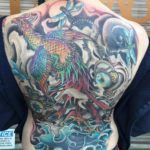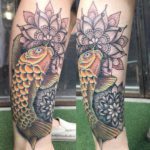Japanese Style Tattoos
If you’re in the market for another piece and are still shopping around for the best approach and local artists, it’s time you consider Japanese style tattoos. If you didn’t know already, tattoos have varying aesthetics from American Traditional to Photo Realism and many more, but few stand the test of time as well as the Japanese style.
This blog will cover everything from where this style got its start, to some of the most reputable and recognizable names in the space, all the way to down to some of the common elements and images you may want to include in your piece. Prepare yourself to dive head first into Yakuza, Irezumi, and more! Keep in mind that Japanese Style Tattoos is a blanket term. Japanese style tattoos may come to life in traditional, modern and even some Kawaii techniques.
This is simply a starting point for anyone beginning their exploration in the Japanese Tattoo space.
Japanese Style Tattoo Origins
You may be surprised to learn that much of modern Japanese art has roots that go back many many centuries. Sure, technology and tattoo sessions may be very different, but much of the symbolism and inspiration behind Japanese Tattoos is alive and well. That said, to truly appreciate what makes Japanese-inspired tattoos so special, we’ll need to do a crash course on its history.
Nowadays, you may choose a Japanese tattoo because you’re simply drawn to the style or want to mark your body with something unique. However, back in their early days, Japanese tattoos (or Irezumi) were typically a symbol of rank, position, class or religious affiliation. Family legacies and stories became woven into visual marks that followed a person, and their body, wherever they went. Japanese tattoos could have ties to home regions, family trades, aspirations and beyond. Surely, they were decorative at times, but they often had deeper meanings such as protection or strength for those who wore them. Somewhere along the way, there was a major shift and emperors even began to use tattoos as a means of marking Japanese criminals, punishing them, and essentially using ink to mark threats to society.
In its original application, Irezumi was actually done by hand with metal needles, silk threads, and a special ink, known as Nara. And back then, you wouldn’t schedule a tattoo with your local artist, you’d have to sit down with a “Brother”, and partake in a process that had been passed down from mentors to apprentices. Since everything was often freehand, there was little room for coming in and demanding a certain piece take place. Rather, the artists embarked on deep dialogue with the candidate to determine how and where a piece should live.
Shortly after WWII Japanese tattooing was forced underground when the art was dubbed illegal by the leaders of the time. As Japan and its people sought to move past the wartime horrors, tattoos and other social norms took on bad connotations and enthusiasts were forced to take their legacy art techniques and styles behind closed door and across the world.
It was during this movement, or perhaps directly because of it, that the Japanese art and the Yakuza (members of a transnationally organized crime syndicate, originating in Japan.) became very close. Regardless, it’s safe to say that modern Japanese tattooing has incredible roots, rich history, and deep symbolism.
All the same, it is alive and thriving (albeit political times and leaders shift, creating constant friction and varying perceptions and possible job repercussions in the native land).
Common Japanese Tattoo Elements
What do you think of when you envision Japanese artwork?
- The Koi Fish
- Dragons
- Flowers
Any of these could be correct, but there is so much below the surface, and many more common themes behind Japanese art. The following article will by no means explore them all, but we’re excited to cover some of the basics.
Japanese Deities
The Buddha is among one of the most common deities in Japanese Tattoos and is said to symbolize one’s devotion or commitment to Buddhism.
Lotus Flowers
Lotus flowers are often a central piece in a modern Japanese sleeve, thigh, or chest piece and typically represent strength and enlightenment.
Japanese Waves
Water in its natural state always conjures the power of ebb and flow. It’s not surprising then that Japanese Waves have become synonymous with living a strong life that flows over, through, and beyond anything that comes in its way.
Koi
Courage, fortune, luck – the Koi Fish is rich in Japanese symbolism and has become a staple in many tattoos. Fun fact: orientation and the direction of the fish also plays a huge role in communicating the symbolism of the fish. Think upstream versus downstream. Generally speaking, if the Koi is facing up, you may be trying to communicate that you’re still amidst the struggle that requires said courage, fortune, and luck. If the fish tattoo faces down, you might be trying to communicate that the challenge is behind you and you’re now flowing with greater ease downstream.
Dragon Tattoos
Western culture usually associates dragons with fear and violence. That may sometimes be true, but Japanese dragon art often elicits wisdom, benevolence, and generosity. And given the grandeur and size of dragons compared to other elements in Japanese style, they make for wonderful, serpentine sleeve elements or shoulder pieces.
Scheduling Your Japanese Tattoo
While we aren’t the brothers you read about earlier, Japanese art is among one of our favorites to plan, prepare, and apply. Our local artists are some of the best in San Diego and we’d love the opportunity to meet and talk through your design. Whether you’re considering a one-off Lotus or a deeply meaningful and integrated back piece, we’d be thrilled to see what we can come up with together.
For more inspiration, be sure to check out a few of our local artists on Instagram! Check out Cari Fox for your Kawaii tattoo interests, she has years of experience in this niche style!



